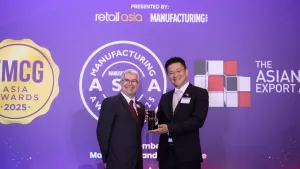Greener power: Cutting the carbon impact of EV battery manufacturing
By Philippe ArsonneauDespite advancements, more needs to be done to ensure that EV batteries are manufactured as sustainably as possible.
According to the International Energy Authority (IEA), nearly one in five cars sold in 2023 were electric vehicles (EVs) – a rise of 3.5 million units compared to 2022. In 2024, global sales of fully electric and plug-in hybrid vehicles surged by 25%, surpassing 17 million units. This rapid growth signals a strong global shift towards sustainable transportation, fueled by growing consumer awareness and demand for greener alternatives.
In Singapore, a YouGov survey revealed that 50% of consumers are willing to pay up to 10% more for sustainable vehicles – significantly higher than the 38% in Indonesia. Meanwhile, a TrendForce study forecasts that the number of public charging stations worldwide will triple to 16 million by 2026, highlighting the accelerating pace of EV infrastructure development.
Whilst the absence of cohesive policies and regulatory incentives remains a challenge, industry analysts suggest that EVs could even support the energy grid rather than strain it, feeding power back when solar and wind energy supplies are low. With this growing momentum, could 2025 be the year that EVs finally become mainstream?
As we race to meet climate targets, EV adoption is undeniably on the rise. However, one key issue persists: the environmental impact of EV battery production.
The grey areas in green vehicles
EVs are often hailed as ‘zero-emission vehicles’ – a claim that holds true when they are powered by renewable energy. However, the process of manufacturing EV batteries tells a different story. The batteries that power EVs are the largest source of embedded emissions in both electric cars and trucks, accounting for up to 60% of total production emissions. This means that the carbon footprint of battery production can equal – or even exceed – the emissions from manufacturing all other vehicle components combined.
Even though EVs begin to offset their production emissions after driving between 10,000 and 30,000 kilometres – far outperforming fossil-fuel-based cars – their sustainability must be addressed from the very start of the manufacturing process.
The European Union has already enacted laws requiring EV batteries to have a lower carbon footprint, contain fewer harmful substances, and be collected, reused, and recycled at high rates. Singapore is following suit, with a policy mandating that all new car registrations must be cleaner-energy models – including electric, hybrid, or hydrogen fuel cell vehicles – by 2030. Additionally, the Singapore Land Transport Authority has approved four "sandbox trials" for EV battery charging and swapping systems, whilst the Malaysia Productivity Corporation has introduced the EV and Battery Management Guideline to establish environmental and safety standards for EV manufacturers in the country.
Asia, a hub for some of the world’s largest EV markets and battery manufacturers, plays a key role in the global EV transition. China leads in EV battery production, whilst South Korea and Japan are making significant investments in next-generation battery technology. Meanwhile, Southeast Asia is also ramping up efforts, with Indonesia emerging as a key player in the EV supply chain, thanks to its abundant nickel reserves, a critical component of lithium-ion batteries.
Despite these advancements, more needs to be done to ensure that EV batteries are manufactured as sustainably as possible.
Unlocking ultra-valuable production data
The EV battery manufacturing sector is navigating a critical transition. Until now, manufacturers have focused on scaling production quickly to capture market share. However, this rapid expansion has led to inefficiencies – especially in data management. The lack of meaningful feedback loops across production facilities has created significant value leaks.
For instance, 25% of power outages are caused by electrical equipment failures. Transformer failures have led to serious disruptions including an explosion in Bangkok. These incidents highlight the need for robust electrical asset management, including predictive maintenance to prevent operational damages.
Moreover, buildings – including EV battery factories – account for approximately 39% of global energy-related carbon emissions. Of this, 28% stems from operational emissions (such as heating, cooling, and powering facilities), whilst 11% originates from materials and construction. To reduce these emissions, manufacturers must integrate connected devices, sensors, and systems to unlock actionable insights into energy facility losses and optimise facility operations.
Driving digitised development
The key to sustainable EV battery operation lies in creating an all-digital, all-electric manufacturing environment. Scope 2 and 3 emissions – those arising from energy use and supply chain operations – are amongst the most challenging to control. By bringing more production in-house, manufacturers can gain greater oversight of energy consumption, material sourcing, and assembly processes.
Predictive maintenance is a crucial enabler in this transition. Artificial intelligence-powered analytics, real-time assets monitoring, and proactive maintenance services can help optimise ageing and under-invested infrastructure, reduce downtime, and enhance efficiency. However, implementing these solutions can be complex and requires expert guidance.
Strategic collaborations with digital solution providers are helping EV battery manufacturers meet the surging demand for sustainable energy storage. By leveraging digital twin technology, manufacturers can create a virtual replica of their production facilities, enabling real-time monitoring and process optimisation. Model-based manufacturing execution systems further enhance efficiency by providing contextual decision-making tools from engineering to operations.
Beyond emission reductions, digitisation gives manufacturers greater control over energy procurement, minimising dependence on critical raw materials and enhancing supply chain resilience.
A sustainable future
EVs are undoubtedly the future of transport, but for them to become the present, manufacturers must address the carbon footprint of their entire lifecycle – from production to the roadway. By embracing digitisation, predictive maintenance, and expert partnerships, the EV sector can drive meaningful change and accelerate the path to net-zero emissions.
With Asia leading the way in battery innovation and EV adoption, the region has a unique opportunity to shape the global transition towards sustainable mobility.
The time to act is now.
















